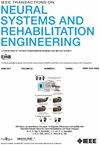Feasibility Assessment of an Optically Powered Digital Retinal Prosthesis Architecture for Retinal Ganglion Cell Stimulation
IF 4.8
2区 医学
Q2 ENGINEERING, BIOMEDICAL
IEEE Transactions on Neural Systems and Rehabilitation Engineering
Pub Date : 2024-12-12
DOI:10.1109/TNSRE.2024.3516492
引用次数: 0
Abstract
Clinical trials previously demonstrated the notable capacity to elicit visual percepts in individuals with visual impairments caused by retinal diseases by electrically stimulating the remaining neurons on the retina. However, these implants restored very limited visual acuity and required transcutaneous cables traversing the eyeball, leading to reduced reliability and complex surgery with high postoperative infection risks. To overcome the limitations imposed by cables, a retinal implant architecture in which near-infrared illumination carries both power and data through the pupil to a digital stimulation controller is presented. A high efficiency multi-junction photovoltaic cell transduces the optical power to a CMOS stimulator capable of delivering flexible interleaved sequential stimulation through a diamond microelectrode array. To demonstrate the capacity to elicit a neural response with this approach while complying with the optical irradiance limit at the pupil, fluorescence imaging with a calcium indicator is used on a degenerate rat retina. The power delivered by the laser at the permissible irradiance of 4 mW/mm2 at 850 nm is shown to be sufficient to both power the stimulator ASIC and elicit a response in retinal ganglion cells (RGCs), with the ability to generate of up to 35 000 pulses per second at the average stimulation threshold. This confirms the feasibility of generating a response in RGCs with an infrared-powered digital architecture capable of delivering complex sequential stimulation patterns at high repetition rates, albeit with some limitations.求助全文
约1分钟内获得全文
求助全文
来源期刊
CiteScore
8.60
自引率
8.20%
发文量
479
审稿时长
6-12 weeks
期刊介绍:
Rehabilitative and neural aspects of biomedical engineering, including functional electrical stimulation, acoustic dynamics, human performance measurement and analysis, nerve stimulation, electromyography, motor control and stimulation; and hardware and software applications for rehabilitation engineering and assistive devices.

 求助内容:
求助内容: 应助结果提醒方式:
应助结果提醒方式:


